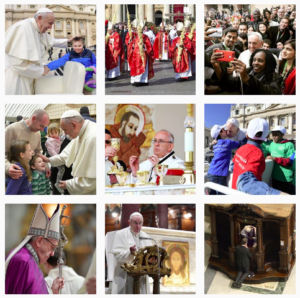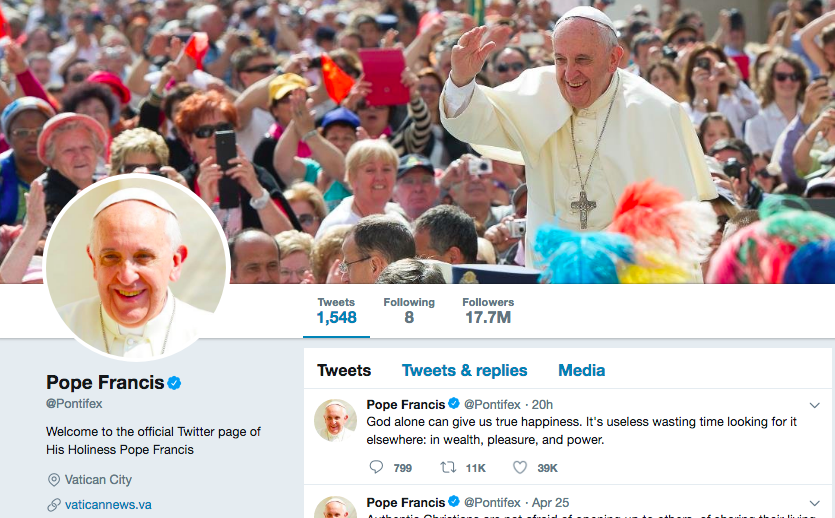– Welcome to the official Twitter page of His Holiness Pope Francis –
Does this sentence seem strange to you?
Pope Benedict was the first pope to adopt modern social media when he opened up what is now Pope Francis’ Twitter account. The very first tweet from the Pope was this: “Dear friends. I am pleased to get in touch with you through Twitter. Thank you for your generous response. I bless all of you from my heart.”
It was exactly 140 characters. Straight and to the point.
The Pope’s introduction to twitter represents the adaptability and flexibility of the Vatican media. But, before I get ahead of myself…let’s take a look at what the Vatican media actually is. Read more to learn about what Vatican Communication looks like, what outlets they use, and current events related to the Vatican media (aka more about Pope Francis on Twitter and Instagram!)

The Vatican News is the landing page for all news that comes out of Vatican City. On the website, you can find all the updates and happenings in the Vatican. There are links to the most recent articles and news stories, a link to the press office, an update agenda of the Pope, and an updated social media ticker.
What the Vatican aims to do is find better ways to communicate with the world, providing an easy and simple way to engage with Vatican news. The Vatican News website is unique – every single story relates to the Catholic church, the Pope, or religion in general. We don’t see that on normal news outlet websites, because they are all tasked with the expectation of covering anything and everything. The Vatican News site has the ability to be more narrow, but still with freedom.
You go to the Vatican News site for one reason: to get the latest news from the Vatican.
The website is also optimized for people of all backgrounds and nationalities. The first window that pops up when you visit the site is one that asks you which language in which you would prefer to read: Italian, English, French, German, Spanish, Portuguese, or Polish.
In a release by the Technology Business Journal, it is stated that “The objectives include the design of the Vatican News, which will help people find and interact with desired information more easily; the creation of one multi-language editorial team able to work with a multimedia, multi-device and multi-cultural approach; and a content strategy that allows for efficient content management and distribution.”
The site is extremely easy to navigate, and you can easily find a link to anywhere else you’d like to go: social media sites, more information on the Pope’s activities, and other important Vatican communication sites. It is the main hub for all communication through the Vatican. The only website that has a separate, fully functioning website is the Vatican newspaper.

As important as digital media is, the Vatican also upholds the dignity of print media in their daily newspaper, titled L’Osservatore Romano.
“From the heart of the Pontificate”
According to a communications specialist at the Pittsburgh Diocese, the newspaper was established in 1861 and is published in multiple languages. It is powered by the Vatican News, but operates under its own name. The L’Osservatore Romano publishes eight sections: Vatican, International, Culture, Relgion, Editorials, Interviews, “Women Church…” and “Santa Marta.” The paper also publishes six days a week, the one day without publication being every Monday.
The “the newspaper” page of the L’Osservatore Romano reads:
“L’Osservatore Romano began with the daily newspaper. Founded in 1861, it has undergone a series of changes to meet the exigencies and expectations of each pontificate. The universal dimension of the Church, the encounter between faith and reason and the Church’s approach to the men and women of today are the editorial lines followed by the Vatican paper. It is both for the purpose of documentation and commentary on all papal texts and documents of the Holy See in Italian as well as in the original languages in which they were spoken or written. Our aim is to provide complete and accurate information on international affairs and the cultural debates and events happening in the Church on every continent. Special attention is also paid to ecumenism and to interreligious dialogue. The daily edition is published six days a week (except for Monday). It can be found at any major kiosk in larger Italian cities or can be ordered by subscription.”

The Vatican Radio can be found directly on the Vatican News site, but they do have their own Youtube channel with many videos (including interviews) you can watch. However, with only 12,000 subscribers, it is not nearly as popular online as the other media outlets. That being said, radio is still popular in Europe, so it is important for the Vatican to broadcast news through the radio.
The radio also broadcasts messages from Pope Francis.

Visually, the Vatican has their own photo service as well. On the Vatican Photo Service webpage, you can find full albums of events, different Popes, and other miscellaneous happenings around the world.
On the photo service website, you can also buy prints if you’d like.

The television broadcasting done by the Vatican Media can be found on the Vatican News Youtube channel. On this channel, you can find mostly Pope visits, mass services, footage from most events, and in most cases, coverage of the events.
Important events are almost always streamed live as well.

The Vatican Publishing House is where basically all information is centralized into one site. It’s an extremely simple website with simple navigation and has information such as details about each Pope, links to the Vatican News site, and links to information about the liturgical year and calendar.
Current Events: as technology changes, how does Vatican media?
Exploring the factors that are forcing the Vatican to restructure their media outlets and plans.
Most of the current articles in the news right now about Vatican communication has been in relation to the swift change of technology. Over the past decade or two, technology has changed so much, and it has proven hard for communications professionals to stay ahead of the game rather than just playing catch-up.
In 2014, Pretoria News, a news outlet of South Africa, published an article that talked about how the Vatican communications team wants to “revamp and modernise” their social media strategy. One of the main strategies implemented, they reported, would be Pope Francis trying to directly reach a wider and younger audience via digital media, primarily social media.
Leszek Gęsiak of the Jesuit University Ignatianum in Krakow, Poland, wrote about the specific changes the Vatican communications team made in his journal review, “Reform of the Vatican media, a difficult search for a new path.” He wrote specifically about the four-year restructuring process that began 2015. In 2015, the Vatican dedicated themselves to the recreation of the media structure, which was actually implemented beginning 2016. In 2016, the two major institutions, Vatican Radio and Vatican TV, were established; in 2017, the Vatican printing press, the photo service, the publishing house, and the newspaper were restructured as well, ultimately making them stronger.
The new system is expected to be highly effective, despite the learning curve that is involved with change, and it is scheduled to be finished at the end of this current years.
Gęisak’s article also discusses the rapid technological growth just like the article from Pretoria News, but specifically mentions the complex avenue that is social media. Social media, as we know, must have a good amount of attention paid to it, or it completely flops. Lucky for the Vatican, Pope Francis does care quite a bit about social media, which I will discuss a little later.
The biggest obstacle in reforming the Vatican media is the deep river of reverence that flows through all topics relating to religion, particularly Catholicism. We have been talking a lot in class about how strictly Italian citizens adhere to Catholic values, and so we can all probably infer that tackling the idea of reform with such a deeply rooted corporation like the Vatican would be tricky. However, the invention and advancement of technology has quite literally forced the Vatican to comply with the changes, which is ultimately a good thing. After all, their main goal is to get the message of the Pope and the Catholic church out to the public and its followers.
The Pope and Social Media: he’s one of us!
Pope Francis once claimed to be a technological dinosaur. How has he changed this image he’s created for himself into a popular public accounts on social media?
In their June 2014 Edition, The Christian Century quoted Archbishop Claudio Celli when he said, “unless the church engages social media, we will wind up talking to ourselves.”


When Pope Francis created his Instagram account under the Instagram name “Franciscus,” people kind of went nuts. While he was the second Pope to use Twitter, he was the first to use Instagram, and it was a choice that he made with very specific goals in mind.
According to an article in The Guardian by Dominic Smith, the launch of Pope Francis’ Instagram page is thought to be an integral part of the Vatican’s plan to up their engagement with younger people all around the world. It seems as though it has worked well, as he has over five million followers on his Instagram page.
Many of the photographs come from the Vatican’s newspaper, the L’Osservatore Romano, showing that all Vatican media tends to be consistent with each other and spread the same content. The hope of the Instagram page was to provide insight into the Pope’s every day life, so people could get more of a visual.

The official Twitter account of the Pope has also proven to be extremely popular, with over 17 million followers. According to Michelle Boorstein and the Washington Post, Pope Francis “became a social media star before the Vatican was ready for it.”
Yes, Pope Benedict tweeted every once in a while, but it was Pope Francis that really sent the Twitter off into space with his humble, kind, and simple tweets. In Boorstein’s words, he is communicating “directly to his flock,” and his followers seem to really enjoy it.
Conclusion: what should you take away?
If you learn one thing from this page, learn that the Vatican is a cohesive but very spread out media service. They want to make sure they are covering all of their bases, which is why they poor a lot of energy into social, digital, and print media all alike. They want to get the messages of the Catholic faith out into the public, and the best way to do that is by sending it in forms the public will actually pay attention to.
The other important theme to remember is that the Vatican works exclusively on their own with no help from outside news service. They are an entirely sole entity that controls what they put out and where they put it.
Thank you so much for reading. I hope you learned something! Ciao!
Works Cited
Christian Century. “Vatican Says the Church Can’t Ignore Social Media.” The Christian Century, 25 June 2014, pp. 17–19.
–
Gęsiak, Leszek. “Reform of the Vatican Media, a Difficult Search for a New Path.” The Person and the Challenges, vol. 7, no. 2, 2017, pp. 5–22. effl.lexxion.eu/article/EFFL/2014/2/281
–
